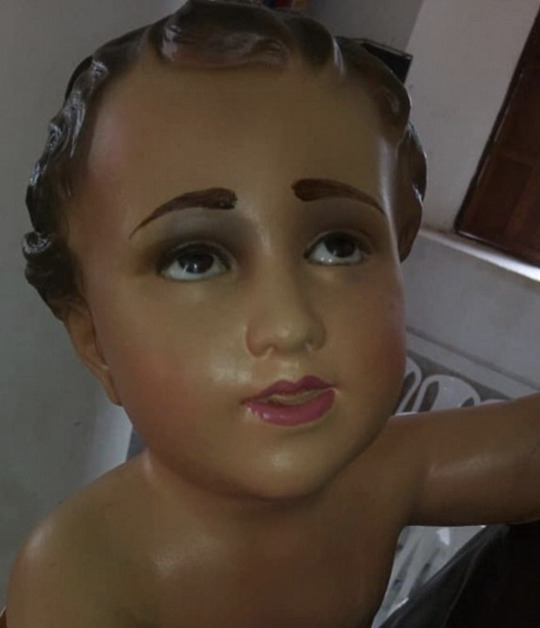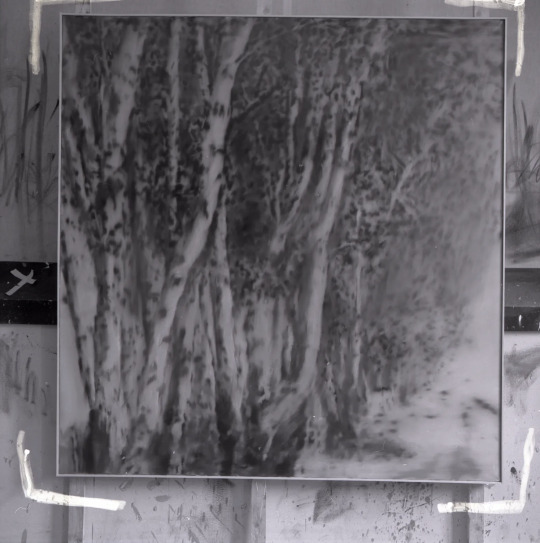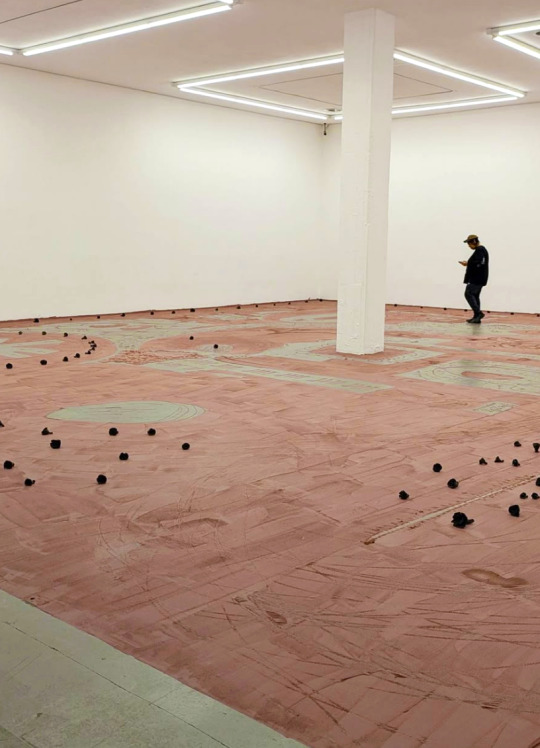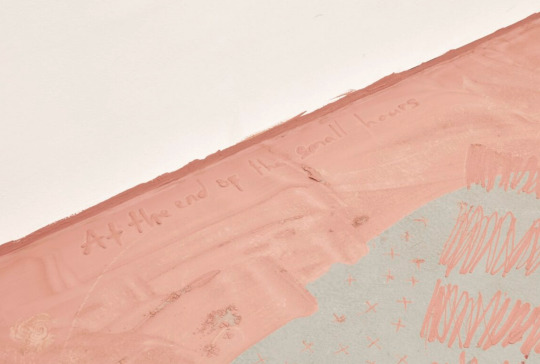research project documenting acts of art vandalism compiled by Christopher Schreck Banana Leaves [email protected]
Don't wanna be here? Send us removal request.
Text
0 notes
Text

Anton Domenico Gabbiani "Portrait of Ferdinando de’ Medici Grand Prince of Tuscany" / selfie
In June 2025, this 17th-century oil painting was damaged while on view at the Uffizi Gallery in Florence, Italy.
Reports say an unidentified museum visitor ("an Italian of about 40 years old") tried to take a selfie with the work but leaned too far, losing his balance and sending elbow through the canvas.
The gallery's director quickly issued a statement, saying that he wanted to set " very precise limits, preventing behaviors that are not compatible with the sense of our institutions and respect for cultural heritage." He added: "The problem of visitors who come to museums to make memes or take selfies for social media is rampant."
Following the incident, museum officials reported that the damage was "minor"; it remains to be seen what a potential restoration might look like.
10 notes
·
View notes
Text



Pablo Picasso "L’hetaire" / paint
In June 2025, this 1901 painting was attacked while on view at the Montreal Museum of Fine Arts.
Footage posted on social media by the climate activist group Last Generation Canada shows an individual (identified by the group as a 21-year-old named Marcel) hurling pink paint from a small container at the work before making a brief speech and being escorted out of the gallery by museum security.
“Today, I am not attacking art, nor am I destroying it," the individual wrote in the group's post. "I am protecting it. Art, at its core, is depictions of life. It is by the living, for the living. There is no art on a dead planet."
In their online statement, the individual also alluded to the city of Winnipeg, which is currently experiencing a record-breaking heatwave. “[W]ere I in Winnipeg right now, would I still be able to make art? Would I have the time, the energy, the resources? Or would I be too caught up in a fight for my survival and well-being, because my government refuses to protect its own people.”
Montreal police confirmed that the individual had been arrested on charges of mischief and was later released with a summons to appear in court. Museum officials later said the painting was protected by a glass case and that no immediate damage to the work was apparent.
2 notes
·
View notes
Text



Nicola Bolla "Van Gogh Chair" / tourist
In June 2025, this sculpture - a common chair adorned with hundreds of Swarovski crystals, meant to allude to a chair featured in one of Van Gogh's most famous pieces - was damaged while on view at the Maffei Palace in Verona, Italy.
As recorded on CCTV, a pair of visitors waited for security guards to leave the gallery before proceeding to pose with the sculpture. As the man takes the woman's photo, she leans in front of the the chair to create the illusion that she's sitting upon it - but upon switching positions, the man takes things a step further by sitting upon the piece, which immediately buckled under his weight. The woman helps him catch his balance, and the two quickly retreat from the gallery.
Officials from the Palazzo quickly took to social media, sharing footage of the pairs' actions, which they called “superficial” and “disrespectful": "Every museum's nightmare has become a reality... They ignored every rule of respect for art and cultural heritage."
The piece was able to be restored in short order and put back on public view within days of the incident - but it remains unclear how those efforts were paid for and whether the couple had been identified and/or would be held responsible for the damages.
5 notes
·
View notes
Text



Terracotta sculptures / domestic tourist
In June 2025, several ancient sculptures were damaged while on view at the Museum of the Terracotta Army of Emperor Qin Shi Huang in Xi'an, China. Reports say a 30-year-old visitor abruptly leapt over guard rails and jumped nearly 18 feet to the enclosure below. Once there, he began pushing and pulling the priceless statues, resulting in visible damage to at least two figures.
Museum security quickly intervened and subdued the individual, who authorities later claimed has a history of mental illness. It's unclear whether the statues, which date back to the third century BCE, will be candidates for restoration.
2 notes
·
View notes
Text



Multiple works by Kamille Lévêque Jégo / vandals
In April 2025, an exhibition of works by Kamille Lévêque Jégo were damaged or destroyed while on view at Galerie NegPos in Nîmes, France.
The exhibition, titled "Cyprine Benzin," had featured a collection of photographic and video works depicting a “gang of girls” asserting their “flamboyant femininity." But less than a month after the show's opening, an unidentified perpetrator or perpetrators broke into the gallery overnight and destroyed more than 30 of the 40 works on view, throwing pieces to the floor and tagging the gallery walls and several prints with spray-painted phalluses and other "immature imagery" along the way.
(This was actually the second attack on the exhibited works; one week earlier, a window was forced open and one work was damaged by an intruder.)
The artist and gallery both feel the attacks were motivated by the work's overt feminist subject matter. Said the gallery's director: "It is really upsetting to see how the masculinist backlash can have such an influence in our society. We have seen verbal protests against feminist exhibitions before, including in our centre, when a neighbor, a convert to Islam, insulted an artist. But never anything like this.” #artdamaged
1 note
·
View note
Text




Statue of Saint Anthony of Padua / restorers
In 2018, this 17th-century wooden statue was the victim of a botched restoration.
The work, installed in a church in Soledad, Colombia, had seen its surface worn away over time (including damage done by termites), so church officials commissioned a local artist to fix and repaint it.
When the work was returned, however, parishioners voiced their dissatisfaction with the results, as their patron saint had been rendered newly "effeminate," with Anthony receiving a pronounced facelift and both he and the baby Jesus now apparently sporting eye shadow, blush, and lipstick.
Restoration experts later suggested that the commissioned artisan, who was paid $328 for his services, hadn't use the "very specific" techniques needed to repaint an antique polychrome wooden sculpture - but from all appearances, no actions have been taken to remedy or reverse this "garish makeover."
4 notes
·
View notes
Text

Mark Rothko "Grey, Orange on Maroon, No. 8" / child
In April 2025, this 1960 painting was damaged while temporarily on view at the Depot Boijmans Van Beuningen during the renovation of the Museum Boijmans Van Beuningen in Rotterdam.
According to a museum spokesperson, the painting sustained "superficial damage" when a toddler touched the canvas in an "unguarded moment." The resulting damage amounted to "small scratches" which are "visible in the unvarnished paint layer in the lower part of the painting."
As far as potential restoration, the spokesperson said, "We are currently investigating, in collaboration with experts, what the next steps for treatment are. We expect that the work can be shown again in the future."
There is, however, some question as to who would be accountable for the costs of such efforts. As it stands, the child's parents could be receiving a steep bill for the repairs; per the London Times, "While the museum does not want to make any statements about the bill, it is generally the rule that costs are recovered from visitors who cause damage."
7 notes
·
View notes
Text


Andy Warhol "Beatrix of the Netherlands" /
In April 2025, officials from Maashorst town hall in Brabant admitted that a rare silkscreen print by Andy Warhol was among 46 artworks that were lost and “most likely” taken by trash workers to a local incineration plant during extensive renovation work in 2024.
The work in question was a 1985 portrait of Queen Beatrix of the Netherlands, part of Warhol's "Reigning Queens" series, which featured 16 colorful prints of four monarchs: Beatrix, Elizabeth II of England, Margrethe II of Denmark, and Ntombi Twala of Eswatini (formerly Swaziland).
“This is not how you treat valuable items,” mayor Hans van der Pas told the public broadcaster NOS. “It is a serious matter when public property, especially art with cultural and historic value, is treated so carelessly … But it happened. We regret that.”
Officials confirmed the fate of the works after receiving a report from an independent investigations agency they'd hired to find out what happened. The agency concluded there were several reasons why the artworks could have been taken out with the trash, including a complete absence of any policies, procedures or guidelines for “the registration, storage, conservation and security of artworks." They also noted that many of the artworks were stored in a town hall basement during the renovation work “but were not handled with care," with several having sustained water and other damage when they were last seen in 2023.
1 note
·
View note
Text



Wim T Schippers "Peanut Butter Platform" / museum visitors
In 2011, an iteration of this 1969 floor-bound installation was damaged on several occasions while on view at the Boijmans van Beuningen Museum in Rotterdam.
The work itself is true to its name: 1,100 liters of creamy peanut butter spread over a 14x4m expanse on the ground. Unfortunately, this iteration of the piece was installed without guardrails, which led to four separate visitors accidentally stepping onto the artwork.
In the wake of these events, museum officials refused to cordon off the piece, explaining that such an intervention would not be aesthetically pleasing. They did, however, send each of the museum visitors a bill for the restoration of the piece, which involved museum staff applying new layers of peanut butter to even out the surface.
15 notes
·
View notes
Text






Various works by Christophoros Katsadiotis / politician
In March 2025, four paintings by Christophoros Katsadiotis by damaged while on view at Greece’s National Gallery in Athens.
Reports say that Nikos Papadopoulos, a fundamentalist MP from the ultra-orthodox Niki party, entered the museum with an unknown individual, tore the framed works from the wall, and threw them to the ground, shattering the protective glass.
The works were on display as part of "The Allure of the Bizarre," a group show of Greek Artists that includes works that caricature religious icons and themes and was mounted as a temporary accompaniment to an ongoing display of 80 engravings by Francisco Goya.
Police arrested Papadopoulos on site and detained him for several hours before releasing him. The politician later told reporters, “I took down four icons, four blasphemous icons, and in two of those ... the glass pane broke, nothing else." He also claimed that works at the exhibition “insult the Virgin Mary, St George ... the archangels that we in our homes were taught to worship and respect.” Papadopoulos aslo threatened to “take all legal actions” against the museum, which he said had detained him illegally since the Greek constitution “provides that a Member of Parliament may not be prosecuted, imprisoned, or otherwise restricted without the permission of Parliament.”
The Museum briefly shut down after the attack before reopening its doors to the public; it remains unclear to what extent the artworks - which included three selections from Katsadiotis's “Icon” series and a separate piece titled Saint Christopher (2020) - were damaged or, if need be, whether they were candidates for restoration.
7 notes
·
View notes
Text











The lost works of Gerhard Richter
As a matter of practice, Gerhard Richter is known to regularly paint over, cut up, burn, and/or trash his own canvases, both in-progress and completed. However, there have been a few instances in which the German artist has destroyed his own work en masse.
First, in 1961, he started a bonfire in the courtyard of the Düsseldorf Art Academy and ceremoniously burned almost his entire existing output, some of which anticipated his well-known photo-sourced figurative work. As he later explained, "I put it all on a bonfire in the courtyard of the academy…I felt the work had to be burned because people were already taking things and paintings were starting to circulate. I had to prevent that because I realized it was time to start from scratch. Photographs were the way forward."
There is also evidence that approximately 60 paintings produced between 1962-65 were destroyed, possibly all at once, but it's hard to say for sure: As Greg Allen explains in his legendary blog, greg.org, these works were ultimately not included in Richter's catalogue raisonné and, having been excluded from the artist's declared oeuvre, there's not much information to go on.
With that said, thankfully, Richter has also long been in the habit of photographing his completed paintings, including those he destroyed soon after, so at least some evidence of these lost works remains.
Slides:
1-7: Destroyed paintings, early 1960s
8. "Hitler" (1962), listed as "believed to have been destroyed" after Richter deemed the work "too spectacular"
9. "Fingerspuren/Finger Marks" (1970), a collaboration with Blinky Palermo, date/circumstances of its destruction unclear
10: "2 Candles" (1982), overpainted in 1996 and retitled "Abstract Painting 837-4"
11. "Hanged" (1988), an identical copy of which was painted over and retitled "Blanket" (also 1988)
4 notes
·
View notes
Text


Andy Warhol "Thirteen Most Wanted Men" / aluminum paint
In 1964, Andy Warhol (along with nine other artists, including Rauschenberg, Kelly, and Rosenquist) was invited to decorate the façade of the New York State pavilion as part of the New York World’s Fair. Taking inspiration from Marcel Duchamp's 1923 work "Wanted, $2,000 Reward," Warhol chose to install a large-scale mural featuring a grid of screenprinted mugshots, which he sourced from a 1962 NYPD-issued booklet titled "The Thirteen Most Wanted."
The resulting piece, which Warhol later said was intended to have "something to do with New York," was to be the artist's first and only public artwork, but it didn't last long: Within days of its installation, objections arose from government officials (NY Governor Nelson Rockefeller was reportedly concerned that the images, which primarily featured men of Italian descent, would be insulting to an important segment of his voter base)*, and two weeks before the fair was due to open, the pavilion's architect, Philip Johnson, told Warhol that he had 24 hours to replace or remove the work.
At first, Warhol offered to replace the mural with 25 portraits of Robert Moses, president of the World's Fair from 1960-66; when officials declined, he gave his permission for his work to be painted over with aluminum house paint. By the time the fair opened to the public, all that was left was a monochrome square colored in silver.
Later that year, Warhol would produce another set of the "Most Wanted Men" paintings with the same screens he'd used to make the mural.
Funnily enough, in his 1980 autobiography, Warhol wrote: “In one way, I was glad the mural was gone. Now I wouldn’t have to feel responsible if one of the criminals ever got turned in to the FBI because someone had recognized him from my pictures.”
8 notes
·
View notes
Text



In Feburary 2025, a 16th-century painting by the Renaissance artist Moretto was damaged while on view at the Santa Giulia museum in Brescia, Italy.
Reports say a visitor was passing by the work when she tripped and fell forward, pushing her hand through the canvas and causing a significant tear.
As it turns out, the work, which was designed to be held aloft at liturgical processions, is actually double-sided, with one side featuring two unidentified saints, the other the Virgin Mary with two disciples. Hoping to allow visitors to view both compositions, the museum apparently installed the work in a freestanding upright display at a gallery entrance rather than mounting the work on a wall; the display was also presented without protective glass.
While the work is still being analyzed by conservators, it will reportedly undergo a full restoration process. Museum authorities also explained that while they're investigating the circumstances of the incident, there are no plans for legal action against the woman who caused the damage.
3 notes
·
View notes
Text




Phoebe Collings-James "red earth, blood earth, blood brother earth [kick dirt]” (2024) / unidentified
In January 2025, this site-specific installation was damaged while on view at the Kunstverein in Hamburg, Germany.
For this piece, the artist covered a museum gallery’s floor with pink dried clay slip. The artist then etched the clay with drawings and phrases, including references to Palestine, Haiti, Sudan, and Congo, before adorning the site with black ceramic roses.
Museum visitors must walk on/across the work in order to view it, inviting an element of "audience participation" via changes to the clay surface due to foot traffic. However, it seems that at some point on January 3, an unidentified visitor actively defaced a section of the work by deliberately scratching out the word "Palestine."
Upon discovering the damage, the Kunstverein publicly condemned the act, calling the vandalism “politically motivated” and revealing that German authorities are investigating the incident as a potential hate crime. As for the work, further details regarding any potential restoration efforts have yet to be disclosed.
18 notes
·
View notes
Text



Andy Warhol "Brillo Soap Pads Box (3 cents off)" / cleaning crew
In November 2024, this 1964 sculpture was inadvertently destroyed when a cleaning crew member working on a yacht mistook the work for the real thing.
The piece, whose 2010 purchase for $3,050,500 later inspired an HBO documentary (2017's "Brillo Box (3¢ Off)"), was apparently being housed on the current owner's superyacht when a member of the vessel's cleaning crew proceeded to throw the piece away, mistaking the Pop artwork (which, apart from being constructed out of wood rather than cardboard, was an exact copy of Brillo's packaging from the time) for an empty box of soap pads.
Interestingly, this isn't the first time a valuable piece of art history was damaged while installed on a luxury ship. In 2019, Japanese billionaire Yusaku Maezawa, who was charting a superyacht with his children an unnamed 1982 work by Jean-Michel Basquiat aboard his own superyacht. Unfortunately, he decided to hang the work near his dining table - and the following morning, when his children sat down to breakfast, they were frightened enough of the painting to throw their cereal at the canvas. The ship's crew, unaware of the prestige of the piece, then furthered the damage by wiping the cornflakes off in an attempt to restore the painting, which was worth $110.5M at the time of the incident.
Concerns surrounding the display of artworks aboard personal sea vessels have apparently increased in recent years among the conservation community. As historian Pandora Mather-Lees has said, while there are superyachts floating around with “better collections than some national museums," which raises real questions about how such artworks are stewarded and preserved. "[Crew members] are expected to know how to serve the owners at sea, not to know about paintings and art. But, now that the rich are increasingly bringing their art collections on board their yachts it’s vital that captains and crew know how to care for these pieces."
In discussing the subject, Mather-Lees (who has been repeatedly called on to restore works following incidents like these) has also alluded to incident in which, amid an impromptu party by a yacht's staff, the cork from a newly popped champagne bottle went sailing directly into a Picasso, damaging the canvas - but she hasn't provided specifics as to the piece, the owner, or the aftermath.
Tilman Kriesel, founder of an art advisory firm, has also shared stories wherein, upon discovering an original Rothko was too tall to fit in their yacht's grand saloon, one wealthy owner decided to hang the work sideways, while another had wanted to display their newly purchased painting by Takashi Murakami in the boat's “beach club” (the rear of superyachts where owners access jet skis and other water toys) - but upon finding it didn't fit, decided to cut away portions of the canvas until it finally did. #artdamaged
4 notes
·
View notes

